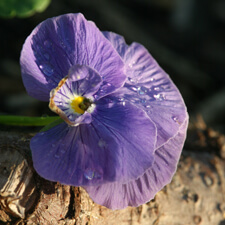
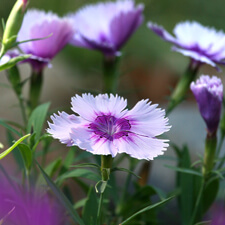
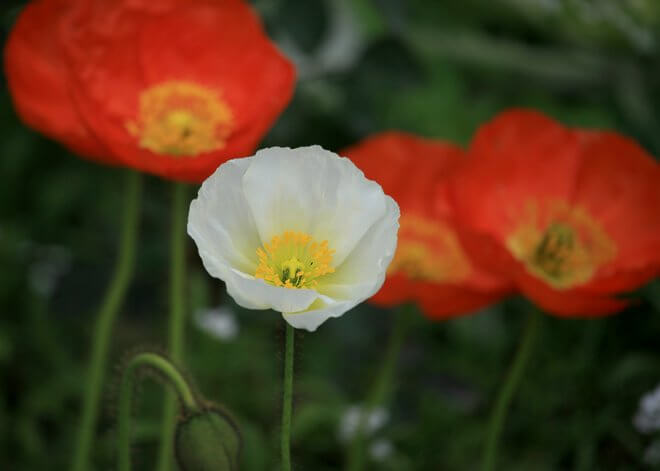
Transplanting During Hot Weather
Fall weather in my zone (9b) can be pretty hot (above 90F) and that’s a problem because I want to get a jump on preparing for the winter garden. Many plants that will be quite happy when temperatures dip below freezing in the winter, will burn up in early fall weather if they are not temporarily protected from the autumn sun. Some flowers I’ve planted recently: Snapdragons, Iceland Poppies, Dianthus, Chrysanthemum palusodum, ornamental kale and cabbage. Snapdragons really don’t like hot weather transplanting (they grow best from seed) and Iceland Poppies are a close second.
How to ease their transition:
- When possible, select plants that are not overgrown for their container or root bound. They are already stressed.
- Plant right away. Don’t let plants languish in the shade or worse, get stressed sitting in the sun.
- Fully saturate the container before planting.
- Transplant early in the morning, or ideally in the evening so the plant has time to settle into its new location before it’s hot again.
- Provide shade until plant is established – meaning that it can be exposed to the sun without wilting.
- Provide a light mulch to shade the soil. I usually lightly scatter some bone and/or blood meal, some coffee grounds (free from Starbucks!) and a light layer of old, dried and shredded wildflowers.
- If snails/slugs are a problem, be sure to protect your new transplants. I put copper scrubbers around each plant (especially delphinium, lupines and anything else loved by slugs/snails), then sprinkle Sluggo. I also also finish with a sprinkling of red hot chile pepper flakes. This is to both kill snails/slugs, but also to keep cats from eating the Sluggo and from digging (they love freshly dug dirt). Read my tips on protecting your plants from slugs/snails and on how to keep cats out of your garden beds.
Do not be tempted to drown your new transplants with water to compensate for the weather. If they are wilting, they do need at least a daily drink of water but in hot weather that typically isn’t enough. Their root systems have not yet adjusted to their new surroundings.
Give ’em a little shade
In my yard, I provide transplants with shade until they are well established and/or the weather cools down to the 70s. Depending on their location and surrounding plants, I use the following to provide shade:
- Shade cloth
- Empty plant containers/6-packs
- Flats
- Garden chairs
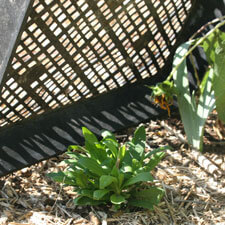
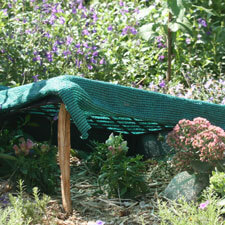
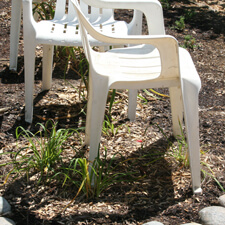
You can use whatever you have on hand to provide some light shade. To make it easy to create mobile shade, I cut shade cloth and stapled it to flats. They are easy to prop up anywhere in the garden. In larger areas, I’ve put up stakes to hold up shade cloth and attached with binder clips.
With small transplants (like from a 6-pack), usually just a couple days or so is adequate for transition. For bigger plants in hot weather, I’ve done it longer. For example, in June I planted two Arabian Lilacs (Vitex trifolia ‘Purpurea’) which was a little late in the season. I kept lawn chairs over them for a couple of weeks to be sure they were happy because it took a while for my local nursery to find them for me and they were spendy.
Lastly, do I recommend transplanting in hot weather? No, not really. It’s only for the impatient gardener like myself who is willing to put in the time to ease the shock of hot weather transplanting.
Do you have any tips that make hot weather transplanting more successful in your garden? I would love to hear from you – please leave a comment below.







Thanks for a helpful article. I’m planting coneflowers in August because this is when they are available at my local Lowe’s. I’ve been shading them, really helps a lot, and you’be given me some good ideas for making shade.
I hope it works for you! August-September, it’s still pretty hot in my yard. 🙂
While weeding the flower beds I always find volunteers (snapdragons, coneflowers, lupine). If they aren’t crowding other plants I leave them until fall. I’ve found I can transplant the coneflowers with little setback by shade/sufficient water. If the plant needs to be removed, I often put it in a container and wait for a cool spell. I store these “new” plants in the shade. Note: coneflower may bounce back if you forget to water it, LUPINE does not. In Idaho, our winters are brutally cold and the temps by end of July and all of August reach the high 90s with no rain. It’s challenging, but so worth it when the flowers bloom!
I like your tips, thanks Ellie! 🙂
While weeding the flower beds I always find volunteers (snapdragons, coneflowers, lupine). If they aren’t crowding other plants I leave them until fall. I’ve found I can transplant the coneflowers with little setback by shade/sufficient water. If the plant needs to be removed, I often put it in a container and wait for a cool spell. I store these “new” plants in the shade. Note: coneflower may bounce back if you forget to water it, LUPINE does not. In Idaho, our winters are brutally cold and the temps by end of July and all of August reach the high 90s with no rain. It’s challenging, but so worth it when the flowers bloom!
Sounds gorgeous, Ellie! 🙂
I must be “impatient”…I moved a butterfly bush on May 13, 2023…..the late morning/afternoon sun is brutal this week. Temperatures are getting to the upper 80’s.
When the plant wilted I was worried I had made a huge mistake. I generously watered the plant and it sprang back. However, the next day, it wilted again. Then I Googled it and found out that I need to protect it from the hot late morning/afternoon sun until it is established. I was careful to get a nice big root ball when I moved the plant. Thanks for your article……
This is just the info I need. I really appreciate the demo photos of how to give the seedlings shade temporarily because I had a real mental block about how to go about it. I have SO many youngish seedlings that really need to be planted and it’s a very hot early July so I feel bit screwed, like putting my babies out to slaughter. I have been evening planting but for many things it wasn’t enough and the sun just destroyed them the next day. So I will try the makeshift temporary shade and hopefully that’s my missing ingredient. Thanks very much!